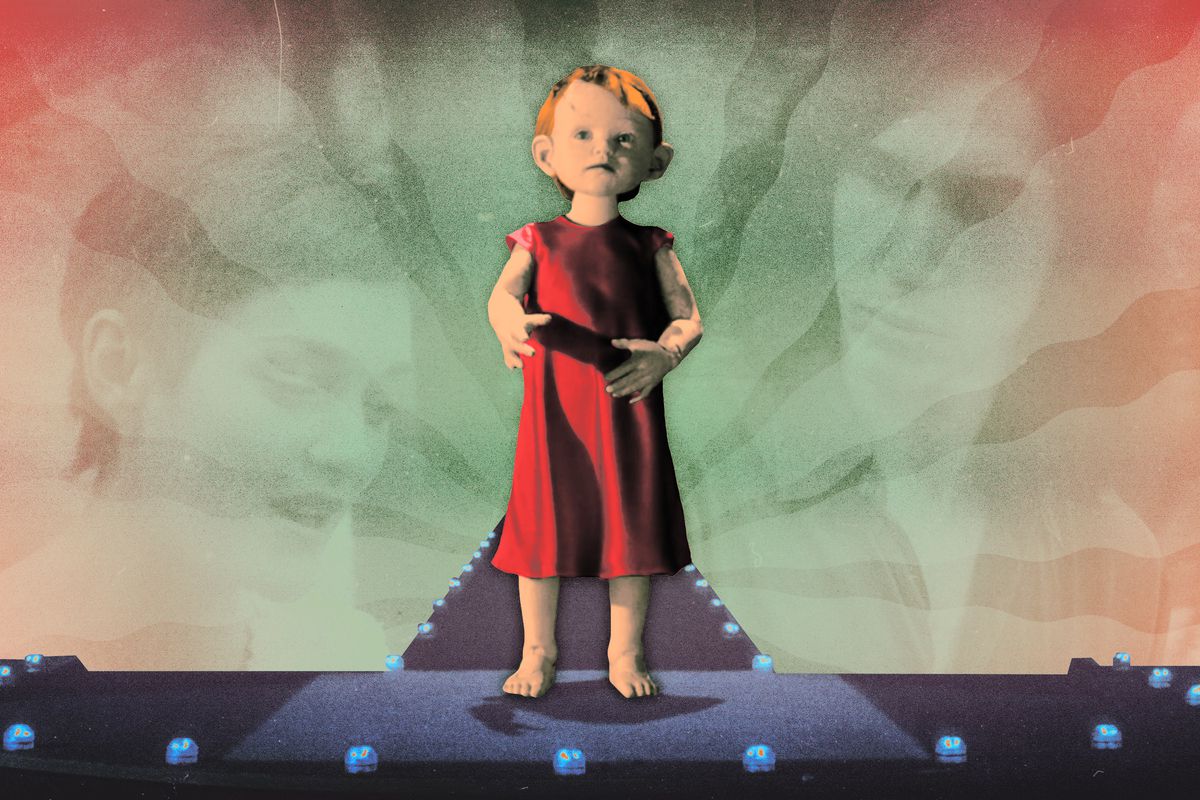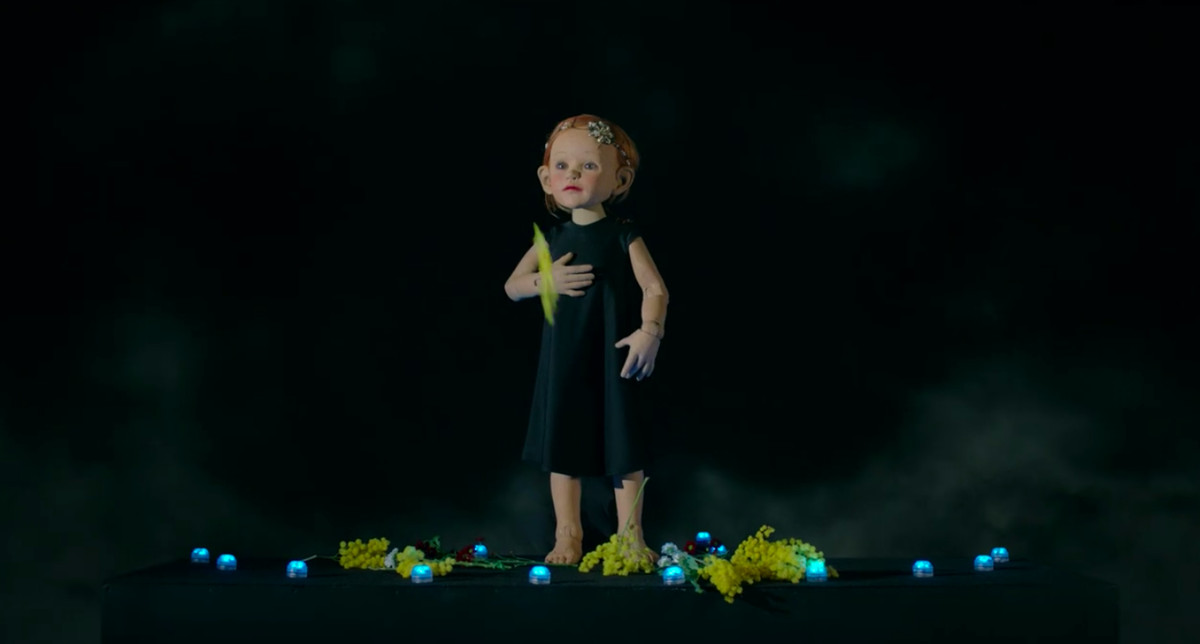 Prime Video/Getty Images/Ringer illustration
Prime Video/Getty Images/Ringer illustrationBaby Annette: The Child, The Myth, The Legend
In Leos Carax’s latest film, a puppet child challenges notions of reality and autonomy.
Warning: this article contains spoilers for Annette (2021).
By natalie duerr
9.22.2021
Babies are problematic—they cry and throw up at the most undesirable moments. This presents problems to high-budget films looking to incorporate newborns into their stories. Recent films like Breaking Dawn - Part 2 and American Sniper struggled to find a solution, using creepy CGI babies and a plastic toy doll, respectively. In their wake, Leos Carax’s conscious decision to use a puppet to portray the titular Baby Annette in his latest film Annette shines.
Annette is a dastardly dream of a story, following Henry McHenry (Adam Driver) and Ann (Marion Cotillard) on their journey through the classic nursery rhyme: first comes love, then comes marriage, then comes baby in the baby carriage. In this case, the baby in the baby carriage is a musical prodigy star that gets caught between her parent’s desire for greed and revenge.
![]()
The genre-bending rock opera has already been quite polarizing (it is Art with a capital A, after all), but Baby Annette’s outward appearance seems to divide further. While nothing in the story is impossible, the presence of a puppet creates a surrealist wash that separates the film from reality. In that sense, the audience can’t take everything at face value. Let’s be clear: Baby Annette is a real baby to the world, and her presentation to viewers is an artistic choice. Ultimately, Annette’s puppet isn’t for the audience to sink into disbelief but rather to help them dive into the film’s murky tale.
Carax worked with puppet designers Estelle Charlier and Romuald Collinet to create Annette’s character. She consisted of nine different puppets to depict her growing up from a newborn to a young child and eventually a real girl. Even though she is a puppet, Annette never misses a beat. Her facial expressions and body shifts are just as one would expect. Driver and Cotillard are committed to the schtick, playing brilliantly off her manipulated movements. The level of craft and detail deployed only heighten the dreamlike state the audience has entered.
![]()
Still from Annette (2021)
The film first introduces Baby Annette when Ann gives birth to her. The moment she is born, doctors describe her as “out of this world.” Annette’s presence seems to be more of a fairytale during her early days compared to what many new parents experience. Instead of changing diapers late at night or cleaning up her mess, the film depicts Henry lifting her in his palm while doing yoga and Ann spinning her around. Here, Annette is all fun and no pain. She is merely a doll holding Henry and Ann’s relationship together.
Annette is a dastardly dream of a story, following Henry McHenry (Adam Driver) and Ann (Marion Cotillard) on their journey through the classic nursery rhyme: first comes love, then comes marriage, then comes baby in the baby carriage. In this case, the baby in the baby carriage is a musical prodigy star that gets caught between her parent’s desire for greed and revenge.

Still from Annette (2021)
The genre-bending rock opera has already been quite polarizing (it is Art with a capital A, after all), but Baby Annette’s outward appearance seems to divide further. While nothing in the story is impossible, the presence of a puppet creates a surrealist wash that separates the film from reality. In that sense, the audience can’t take everything at face value. Let’s be clear: Baby Annette is a real baby to the world, and her presentation to viewers is an artistic choice. Ultimately, Annette’s puppet isn’t for the audience to sink into disbelief but rather to help them dive into the film’s murky tale.
Carax worked with puppet designers Estelle Charlier and Romuald Collinet to create Annette’s character. She consisted of nine different puppets to depict her growing up from a newborn to a young child and eventually a real girl. Even though she is a puppet, Annette never misses a beat. Her facial expressions and body shifts are just as one would expect. Driver and Cotillard are committed to the schtick, playing brilliantly off her manipulated movements. The level of craft and detail deployed only heighten the dreamlike state the audience has entered.

Still from Annette (2021)
The film first introduces Baby Annette when Ann gives birth to her. The moment she is born, doctors describe her as “out of this world.” Annette’s presence seems to be more of a fairytale during her early days compared to what many new parents experience. Instead of changing diapers late at night or cleaning up her mess, the film depicts Henry lifting her in his palm while doing yoga and Ann spinning her around. Here, Annette is all fun and no pain. She is merely a doll holding Henry and Ann’s relationship together.

Still from Annette (2021)
It isn’t until the final act that Baby Annette finally outgrows her puppet appearance. She is now her own person, no longer under the grips of her mother and father. As Henry tries to express his so-called love for her and explain away his misdoings, Annette (now played by Devyn McDowell) shuts him down. As his daughter leaves the room, Henry discards the puppet version. He stares into the camera, saying, “stop watching me,” and then drifts to the corner of the room. The camera pans to puppet Annette sprawled on the floor, face down.
With the end of the illusion of Annette as a puppet, the final act begs the question: whose version of the story were we told? Is it possible that Annette was Henry’s last attempt at convincing an audience that he was indeed the good guy? Now that Annette is out of his grip, no longer a toy that he can wind up to sing for crowds or a naive child he can manipulate into loving him, she is dead to him. He tells us to stop watching in defeat, admitting he can no longer control the narrative to make himself look like “the Hero.”
By using a puppet to play Baby Annette, Carax exposes the first layer of the film’s veiled core. Carax’s decision, along with Charlier and Collinet’s work, further explores the film’s artifice and critique of fame, parents who use their children for personal gain, and toxic masculinity. Annette may leave you with more questions than answers, but Baby Annette’s performance certainly deserves a standing ovation.
